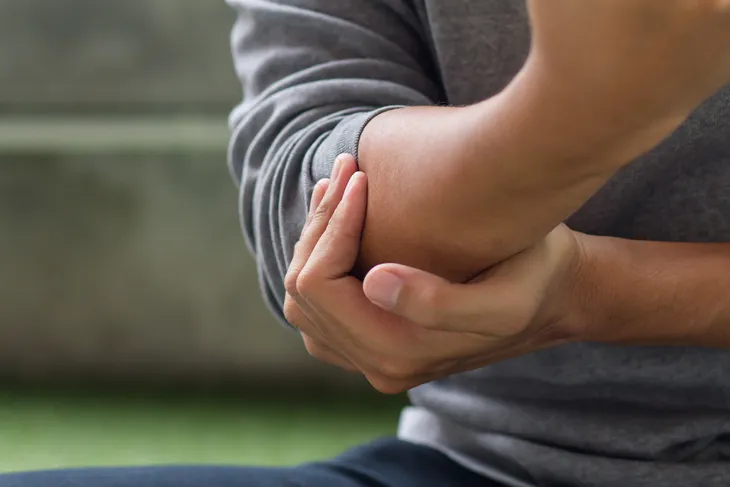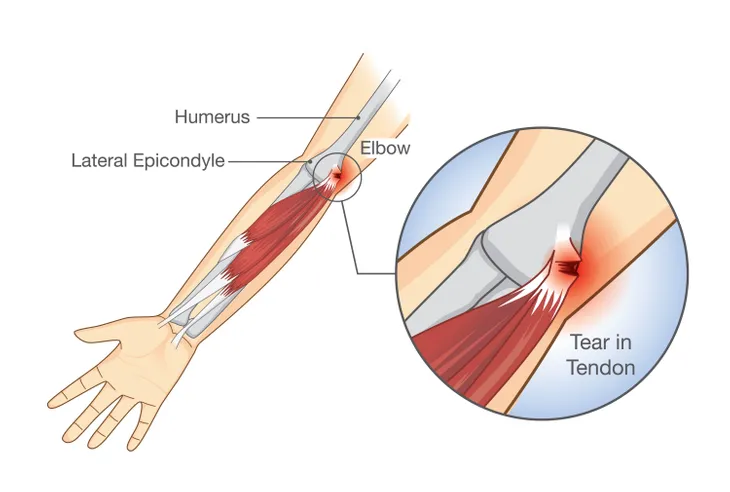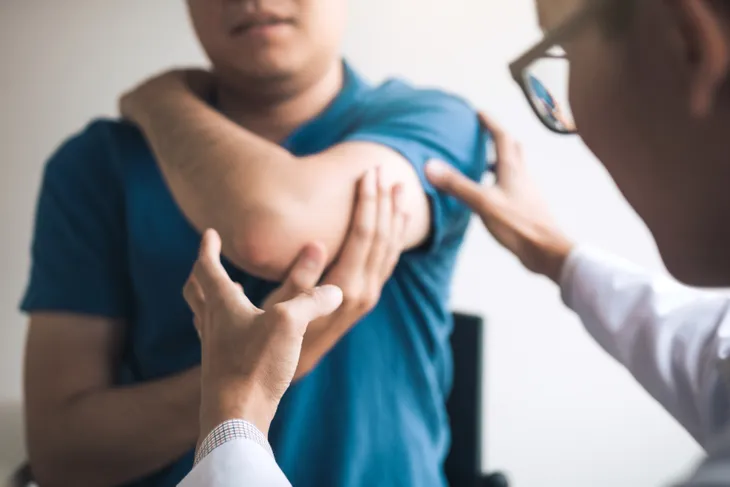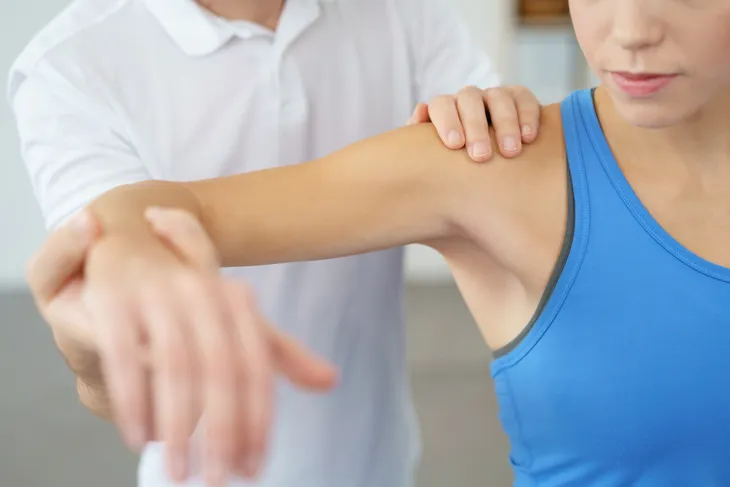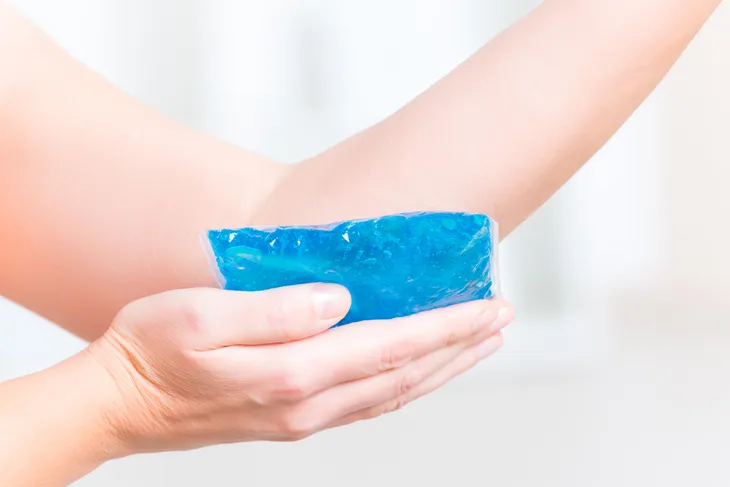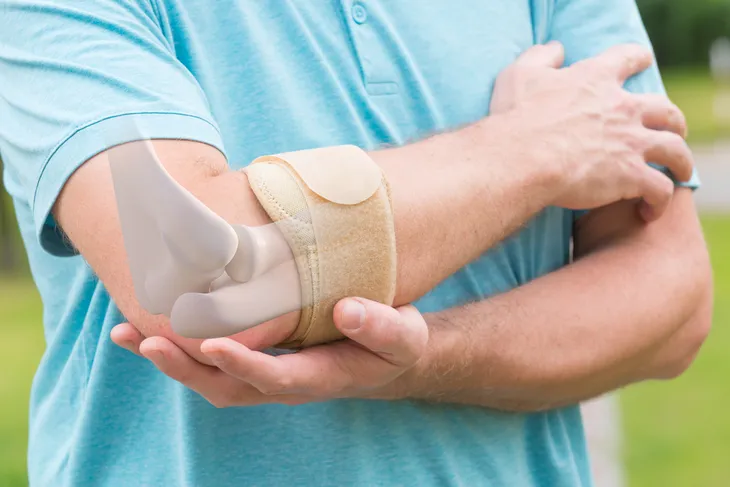- Tennis elbow is a medical condition that develops by overusing the forearm muscles and tendons.
- Tennis players are susceptible to tennis elbow but they’re not the only ones. Any task that requires repetitive motion in the forearm can cause tennis elbow.
- The good news is there are several ways you can help prevent tennis elbow from developing in the first place.
You don’t have to be Andre Agassi or Serena Williams to end up with tennis elbow. In fact, you might end up with the painful condition, which is caused by repetitive stress of the forearm, arm, and hand muscles that penetrate the elbow, even if you’ve never swung a tennis racket.
So before you shrug off that dull, chronic ache in the back of your forearm, consider these facts about tennis elbow including the common causes, symptoms, and treatment options.
What Is Tennis Elbow?
Tennis elbow, known clinically as lateral epicondylitis, is a medical condition that typically “occurs due to overusing the forearm muscles and tendons and those around the elbow joint,” explains Medical News Today. The source says roughly 1- to 3-percent of the American population is affected by tennis elbow and it usually occurs between the ages of 30 and 50.
Don’t mistake the condition as one that only targets tennis players. Tennis elbow can strike anyone who overuses the tendons in the forearm (close to the elbow), which explains the pattern of pain.
Why Is Lateral Epicondylitis Called Tennis Elbow?
As mentioned, you don’t have to play the sport of tennis, or even have ever swung a tennis racket, in order to develop tennis elbow. WebMD specifies that lateral epicondylitis can result from any type of repetitive stress of the wrist extensors.
For instance, tennis players often overwork the tendons in the wrist and forearm when they swing a racket. This is how the condition got the name tennis elbow. That said, other occupations are also susceptible to the condition, such as painters, plumbers, or those who type on a computer all day.
Common Symptoms of Tennis Elbow
The most prominent symptom of tennis elbow is “ recurring pain on the outside of the upper forearm, just below the bend of the elbow,” explains Medical News Today. You may also feel pain further down your arm, near the wrist.
Pain is often felt when you need to lift or bend the arm. Weight-bearing movement, such as opening jars or doorknobs or using tools, will also often exacerbate the pain and decrease your grip strength.
What Causes Tennis Elbow?
Tennis elbow typically develops when a specific muscle (the extensor carpi radialis brevis muscle) in the forearm becomes damaged, says Healthline. To better understand the composition of your forearm, the source explains that a tendon is the part of the muscle that attaches to your bone. In the forearm, your “tendons attach the forearm muscles to the outer bone of the elbow.” So, what causes this muscle to become damaged in the first place?
Damage develops from repetitive stress, which causes tiny tears in the tendons that attach your forearm muscle to the outside of your elbow. “These tears lead to inflammation and pain,” explains the source.
Other Causes
Tennis elbow most often occurs in individuals who have occupations or partake in hobbies that cause repetitive stress to the wrist and forearm. Tennis elbow can be caused by daily activities, such as gardening, texting, using scissors, or cutting tough food, says Medical News Today.
Certain occupations that use repetitive twisting of the wrist can also lead to tennis elbow. This may include occupations such as a painter, plumber, or construction worker. Certain sports can also cause the condition to develop, such as swimming, golfing and tennis and other racquet sports. In some cases, there is “no apparent cause, says the source.
Risk Factors
While anyone can develop tennis elbow, certain factors may increase your risk. For example, the Mayo Clinic says your age may be a risk factor. Tennis elbow is most common in adults aged 30 to 50.
As we know more about the causes of tennis elbow, it’s no surprise that certain occupations that require repetitive motions can also increase your risk, as can participating in sports that require repetitive stress to your forearm. Using poor technique in both your occupation and when playing sports can also cause tennis elbow to develop.
When to See a Doctor
WebMD says tennis elbow can develop in one or both arms. Symptoms can improve on their own with at-home care with rest and ice; however, if your symptoms don’t improve after a week or if they get worse, contact your doctor.
The source says you should also contact your doctor if you develop severe symptoms. Some of these include:
- Difficulty moving your arm
- If the pain interferes with your daily activities
- If there’s a bulge or lump in your arm
- If the area around your elbow is red or swollen
Diagnosing Tennis Elbow
To diagnose tennis elbow, your doctor will likely start with a physical exam. They will inquire about your occupation and whether you play any sports. They’ll also ask how your symptoms developed. Be sure to provide as much information as possible.
Your doctor will also perform simple tests to confirm a diagnosis. This may include applying slight “pressure to the spot where the tendon attaches to the bone to check for pain,” explains Healthline. In some cases, imaging tests (such as a magnetic resonance imaging scan or X-ray) may be necessary to rule out other disorders, such as arthritis.
Relieving Tennis Elbow Pain
Stretching the painfully inflamed areas will often help lessen the achy, burning sensations associated with tennis elbow. Physical therapists often recommend stretching exercises that target both the wrist flexors and extensors.
You can safely stretch the wrist extensors, and relieve some pain by straightening the arm fully out in front of you with your palm facing down. Bend your hand at the wrist and use the opposite arm to push the back of your hand downwards (until you feel a good stretch in the top of the forearm). To stretch your wrist flexors, turn your straightened arm palm up and push your hand backwards, bending at the wrist and stretching the bottom of the forearm. Hold both stretches for 10-seconds and repeat on the opposite arm.
Encourage Tendon Healing
Many doctors and physical therapists will also recommend giving yourself an ice massage to treat the pain and decrease the inflammation associated with tennis elbow. The cooling sensation of laying an ice pack on the area will constrict blood flow.
An ice massage, applied in circular motions using ice in a soft towel or frozen in a paper cup, will diminish inflammation, dull pain, and encourage circulation of blood while alternately constricting and dilating blood vessels, triggering a rush of fresh blood to the area and promoting tendon healing.
Decrease Repetitive Stress
To encourage healing, a routine of stretching, massage to increase blood flow, and limiting repetitive stress to the inflamed and damaged area is important for healing. To greatly decrease continued stress and prevent further damage to tendons, assistive work and athletic devices can be employed.
For instance, wearing a doctor-prescribed counterforce brace, which is an elastic band that encircles the forearm tightly below the injured tendon can reduce pain and further injury. Your physical therapist may also ask you to avoid movements that cause you pain, such as gripping objects or swinging the arm.
Preventing Tennis Elbow
The good news is there are several ways you can help prevent tennis elbow from developing in the first place. For starters, make sure you’re using the proper equipment and technique. This applies to both sports and tasks that require repetitive motions with your wrist and forearm.
Medical News Today says another way to prevent tennis elbow is to always warm up before playing a sport that involves repetitive arm movements. Gently stretching your arm muscles can help but be sure to do dynamic stretches before exercise and only do static stretches after exercise. Dynamic stretches help encourage blood flow to your muscles and static stretches after exercise can help encourage flexibility and range of motion.
Increasing the strength of your forearm muscles is another great prevention method, as is seeing a physical therapist regularly. A physical therapist can help teach you suitable exercises that you can practise at home.

